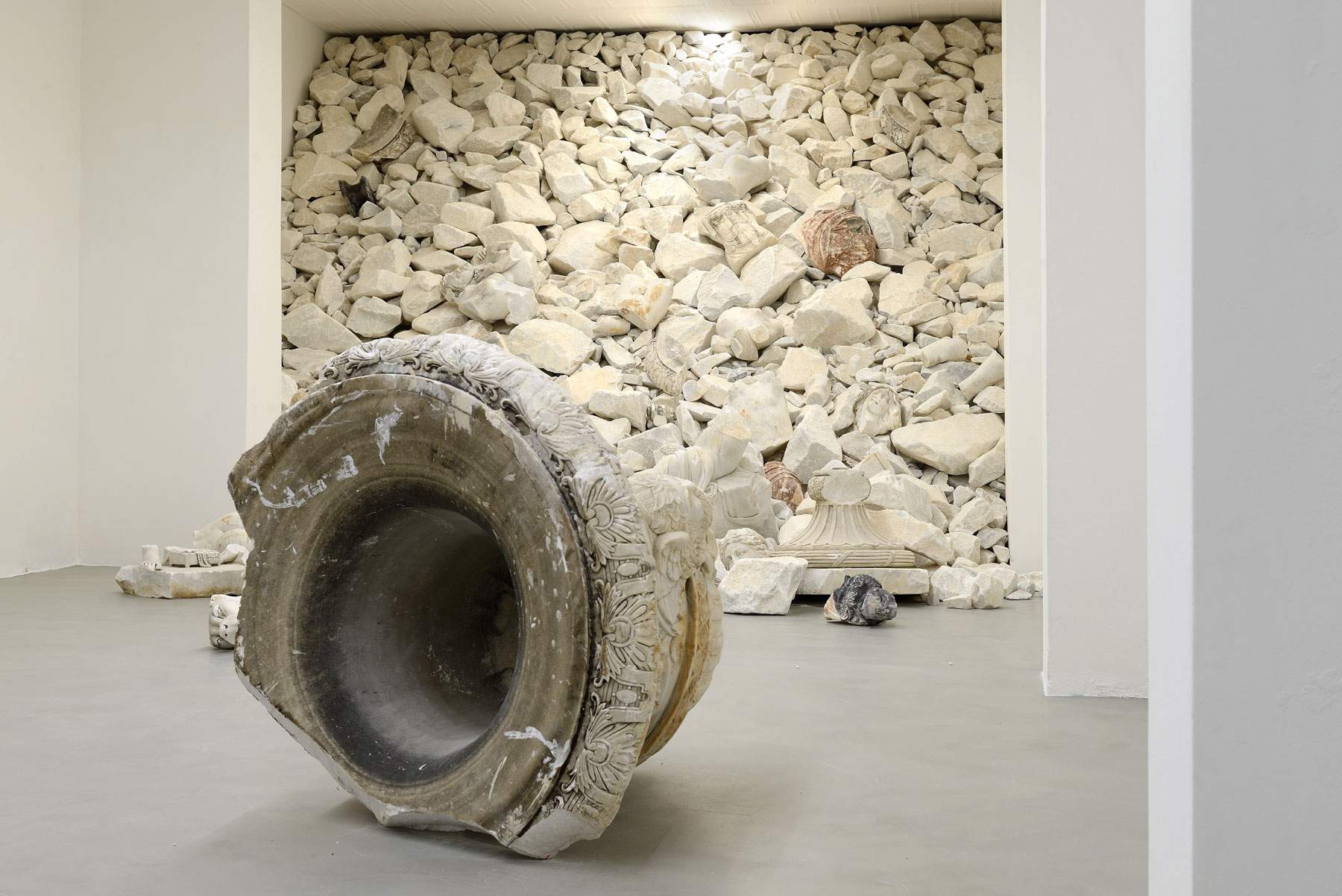Acqua alta: Fabio Viale reflects on the drama of Venice and the passage of time with his marble works
After his success at the Venice Pavilion of last year’s Biennale, Fabio Viale (Cuneo, 1975) returns with a solo exhibition, which aims to open a reflection precisely on Venice. The exhibition, based at Galleria Poggiali in Florence from April 22 to May 16, 2020, is entitled Acqua alta - High tide, and features two different installations: one for the venue in via della Scala 35/Ar, which comes directly from Venice, and the other, monumental, set up in the space in via Benedetta 3r, where quintals of marble have been placed to form a steep “waterfall” of crushed stone.
The spaces on Via della Scala are occupied by the group of sculptures the artist made especially for the Venice Pavilion (at the Giardini) at the 58th Venice Biennale, which ended last November. They are a dozen stone monoliths that replicate, at actual size, the bricole of Venice, the groups of wooden poles (oak or chestnut) three meters other and that are planted in the Venice lagoon to mark the navigation routes. The bricole made by Viale in marble imitate wood so amazingly that one might believe these sculptures are actually casts. The Poggiali Gallery’s display was designed to recall the one in Venice, but not only that, because in the meantime a piece of news has been added that has woefully transformed the virtual into the real. In the Pavilion at the Giardini, in fact, the original landscape, i.e., that of canals and the Venetian lagoon characterized by bricole, was evoked with a multisensory installation that immersed visitors in a realistic environment thanks to a floor immersed in a carpet of shallow water and a fog made of slightly opaque plastic sheets that separated visitors from the stone poles.
The drama of high water, hence the title of today’s exhibition, changed everything, proving that reality many times exceeds our imagination. In fact, high water also invaded the Pavilion where Viale’s sculptures were still located-all the more reason to push the sculptor to keep the original idea in this exhibition on Via della Scala. That is, to basically emphasize the emergency we are going through, that of rising sea levels, climate change and uncontrolled progress that has disrupted natural balances and the landscape in every part of the world. The gallery is dotted with “bricolas” in a path where the long poles sometimes solitary, sometimes “embraced” by narrow chains, become warnings. The arrangement, thus resolved, takes on a dramatic aspect and serves to link the disturbing events of these days, a consequence of climate change, to what was experienced in Florence in the fall of 1966, when the Arno overtopped its banks, and with all its devastating fury the river invaded the city center, reaching the height of many meters in certain neighborhoods, such as that of Santa Croce. Even today, a plaque commemorates the water line in Via della Scala and Piazza Santa Maria Novella, where two meters were exceeded, defacing precious frescoes and fine marble at the base.
Instead, in Via Benedetta Viale has created, as mentioned above, a monumental installation by overturning quintals of crushed stone, or marble debris from the Apuan Alps directly taken from the ravaneti, or overhangs where the waste from quarrying is dumped: unusable rubble and splinters, material produced by the crushing of stone that, as it precipitates and slides downstream, crumbles and creates marble waterfalls, which seen from the marina look almost like glaciers. Amidst the formless mass of debris, which seems to move like a river and drag everything with it, however, emerge from the Viale installation broken statues, shattered pieces of marble vases, limbs and stone heads worked by time and fall. The Three Graces have been shredded, a picturesque character, a turbaned Moor, appears restored to the rough stage of boulder, and again a graceful Apollo is without arms, legs and head, while a molossus is returned to nature as a river stone. The landscape can remind us of the inevitable tragedy of becoming that reduces everything to dust.
Viale’s work seeks to harken back to the Renaissance, when the experience of transience and the end, even that of empires and glorious dynasties, was represented with meaningful images and symbols, such as broken columns, ruined buildings, sculptures rendered formless by the slow and inexorable workings of time. The fascination of these figurative warnings, with their reposed moral meanings, came from the contrast between the beauty of the artifacts, the perfection of the arts, and their opposite appearance in decay.
Fabio Viale has a very special relationship with the Carrara marble quarries, where the purest marble in the world has been quarried since the time of Julius Caesar. Many of his best-known sculptures were carved in the statuary marble, considered the most prized for its luster and softness. Viale grasped technical secrets from the old quarrymen, on how to handle boulders and how to intuit the best shape, and sharpened the sensitivity to recognize qualities and merits of the stone to be carved. For Viale, the task of art and poetry is to bring to us the unpredictable image, the one that awakens in us another cognitive experience, dormant truths, removed or different, concealed by habit, stereotypes, prejudices.
The exhibition opens daily from 10 a.m. to 1 p.m. and 3 p.m. to 7 p.m., Sundays by appointment. Free admission.
 |
| Acqua alta: Fabio Viale reflects on the drama of Venice and the passage of time with his marble works |
Warning: the translation into English of the original Italian article was created using automatic tools. We undertake to review all articles, but we do not guarantee the total absence of inaccuracies in the translation due to the program. You can find the original by clicking on the ITA button. If you find any mistake,please contact us.




























